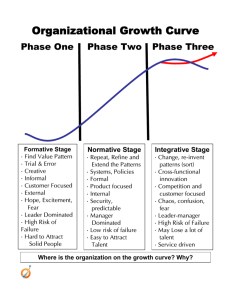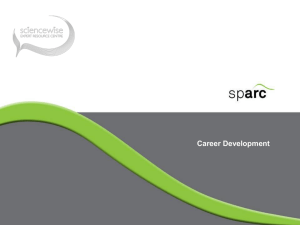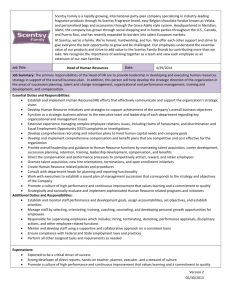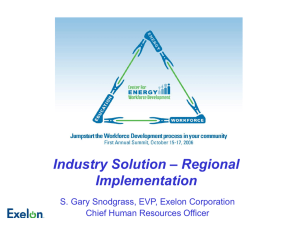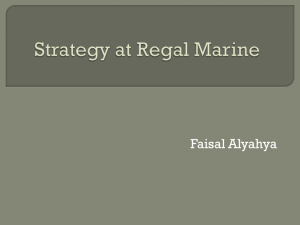HR Strategic Plan 2015
advertisement
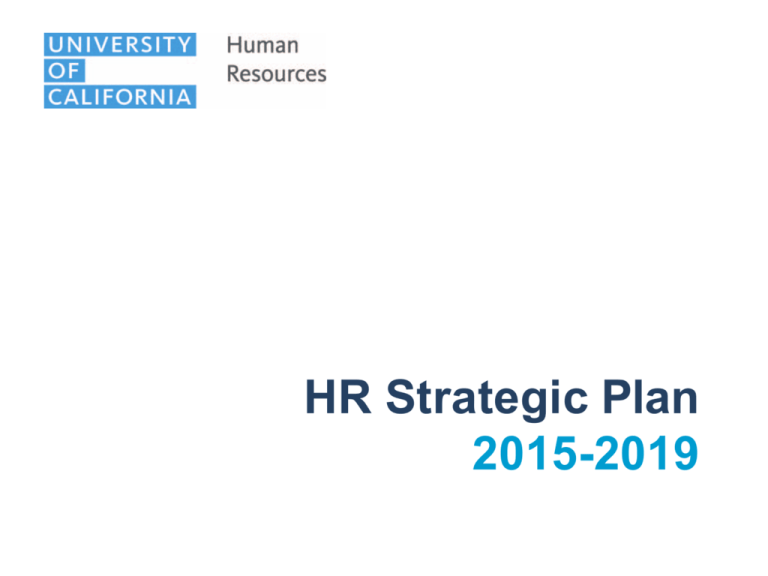
HR Strategic Plan 2015-2019 Vision Strategy Tactics Transaction Reaction Something happens we have to fix External influence drives action Crisis management Timing: NOW Set of steps triggered by an occurrence Dominated by rules and standards Typically one right answer Timing: Completed in 2-3 days Target set Road map to achieve it in place at start Road map may contain contingencies that don’t require consultation Multiple targets or initiatives Involves a series of aligned tactics Incorporates the movements of multiple units/functions Usually incorporates one unit Timing: One month to 2 quarters Timing: One year or more “The headline” The ideal Future State Incorporates operating environments, philosophy and way of doing business Takes into account external perception of an entity Timing: Is probably never fully realized in all aspects “Regenerating Improvement” Benefits Programs & Strategies Strategic Themes: Align programs to meet the various markets reflecting the changing workforce at the University Mission: Manage and create a health benefits strategy and programs that enhance the well-being of our employees/retirees and their families STRATEGIES SO THAT… • • • • • Control costs and create value for employees through plan design Focus on giving employees choices and alternatives Recognize critical nature of UC medical enterprise with regards to pricing Provide a consistent level of service for all employees ( Health Care Facilitator function) • • FUTURE IMPLICATIONS • We establish programs that are • market competitive and sustainable We more effectively partner in shared outcomes with UC medical • enterprise We communicate clearly on choice, value and accountability January 2015 Stabilization of cost curve Emphasize employee responsibility in a less paternalistic culture UC Medical Enterprise becomes a core health provider and assumes a role in stabilizing the cost curve Compensation Programs & Strategy Strategic Themes: Align staff compensation programs with relevant markets (particularly total cash). Promote understanding of compensation at UC, and recognize compensation as a competitive tool to drive organizational results. Mission: Provide tools to managers to administer programs in a fair, efficient and consistent manner. Create and deliver robust education and training to managers and employees regarding compensation programs and the role of these programs at UC. STRATEGIES SO THAT… FUTURE IMPLICATIONS • • • • • Establish and implement marketbased system-wide compensation programs and practices Implement and communicate common frameworks for position evaluation and performance management Streamline, simplify and automate processes and procedures • • • We are able to respond to our relevant markets We drive consistency of practices, set appropriate review and monitoring systems Provide timely, accurate data to the campuses, President and The Regents We balance all other types of rewards within a total package January 2015 • • • Moving toward market alignment allows us to make competitive talent choices Predictable pay practices will drive internal credibility to help us attract and retain talent Moving to more strategic approach to compensation A sustained excellent workforce and university Employee Relations Strategic Themes: Operate as an excellent employer Mission: Build an environment of employee engagement, empowerment and involvement where people can offer their best; equip managers with tools, resources and a policy framework that facilitates an effective operating environment STRATEGIES • • • • • Have Employee Relations (ER) strategies lead Labor Relations (LR) strategies Continue to distinguish the function of ER from LR Increase interface with nonrepresented employees Acknowledge the importance of a regular salary increase program Continue to build a culture that embraces performance SO THAT… • • • • • We build a healthier UC culture: one of self reliance and accountability We increase employee engagement and satisfaction We continue to improve our reputation with all employees The dialogue between the manager and employee is frequent, open, honest and supportive Employees feel valued and appreciated January 2015 FUTURE IMPLICATIONS • • • Sets the environment to attract and retain the best talent Drives productivity by incorporating employee satisfaction and engagement An enabling culture that fosters trust, respect and inclusion of diverse ideas HR Compliance and HR Policies Strategic Themes: “Inspect what we Expect”. Achieve positive benefits of compliance efforts . Mission: Promote culture that is compliant with regards to various HR policies, programs and processes STRATEGIES SO THAT… FUTURE IMPLICATIONS • • • • • • • • • • Integrate technology into compliance activities Increase educational and awareness efforts Position compliance as an efficiency tool Look for new ways to resource the HR Compliance function Fully integrate compliance expectations within the policy framework Appropriately standardize the execution of HR policy provisions Develop clear understandable HR policies that balance the interests of both management and employees • • • • • We use readily accessible data to provide assurance to leadership We extend best HR practices throughout UC and minimize financial and reputational risk Following the rules fosters greater efficiency and reduces unnecessary expense The implementation of policies & procedures conform with regulatory and HR policy requirements HR’s accountability is enhanced by following HR policies Employees understand the value of policy provisions and supervisors can implement fairly January 2015 • • • A culture of greater accountability Savings from addressing risks of noncompliance can be re-deployed Doing things right builds trust and integrity The first and preferred course of action is to follow HR policies in word and spirit Enhanced workforce awareness regarding the value of the terms and conditions of employment at UC Labor Relations Strategic Themes: Creating a predictable, respectful, compliant, labor relations environment; alignment and consistency with the overall employee relations strategy based on proactive open communications. Mission: Facilitate the achievement of university/campus/location and operating objectives while providing support, information, and services to leadership and management. Achieve systemwide understanding of our contracts and awareness of our unions’ objectives. STRATEGIES SO THAT… FUTURE IMPLICATIONS • Foster more frequent open communications • Promote managerial and leadership’s knowledge through training • Align standards in approach between Employee Relations and Labor Relations • Begin laying the foundation for future bargaining now via open dialogue with our unions • Resolve labor disputes and issues at the lowest possible level • We proactively discuss and resolve issues, build trust and avoid allegations of bad faith • We minimize grievances, arbitrations and unfair labor practice charges • We create a consistent standard of treatment across employee groups • We have more timely efficient bargaining with fewer surprises at the table • We build upon the relationships and trust between employees and their supervisors, creating a more open empowered working environment. • A continuation of labor peace and stability • A more stable productive operating environment with fewer conflicts and crises • It is neither an advantage nor disadvantage to be represented or non-represented • We avoid operational disruptions and create a foundation of mutual interests wherever possible. January 2015 Retirement Programs & Services Strategic Themes: Leverage enhanced technology and self service to improve and expand the RASC service model concept so that employees can best understand, plan for, and access the UC retirement plans and the Retiree Health Program. Mission: Create, manage, and administer retirement programs and services that reward long service and help provide for post-employment income and healthcare. Deliver the value through a state-of-the-art retirement processing center and self-service experience that helps employees transition to the next phase of their lives and that supports retirees and their survivors. STRATEGIES SO THAT… • • • We reduce transactional work to improve efficiency and maintain the compliant operation of these valued, integrated programs • RASC Staff is trained and motivated to provide accurate and consistent services • Bench strength for future leaders through succession planning and talent retention • UC maintains a competitive, strategic advantage to attract and retain talent • High caliber workforce that executes our institutional priorities • • • Continue to integrate the retirement administration service center (RASC), actuarial services and pension & retirement programs to provide a comprehensive suite of services. Enhance the customer experience through implementation of enhanced technologies with an emphasis on self-service Change culture through a shared vision to prepare and develop RASC staff for upcoming changes Promote recognition of UC’s post-employment benefits as integrated parts of the employee lifecycle January 2015 FUTURE IMPLICATIONS Scale concept and administrative efficiencies for other centralized HR transactional work and services Talent Management & Staff Development Strategic Themes: Programs to better manage human capital, the University’s primary asset Mission: Design an approach, strategies and programs to hire, deploy, develop and retain the best people in their respective fields STRATEGIES SO THAT… FUTURE IMPLICATIONS • Acknowledge the critical nature of Talent Management current state, outlook and challenges across UC • Establish discipline and best practices around a culture of talent management • Facilitate conversation and development of succession strategies to prepare future leaders for management and leadership across UC • Establish diversity as a key pillar to our talent management strategy • Provide tools, systems, processes and best practices that prepare us for internal and external environmental changes • Build capability among HR professionals to be more active talent managers • UC creates an environment where organizational opportunity meets readiness of individuals • UC has a comprehensive and competitive Executive Recruitment focus • UC improves our status as a preferred employer by becoming competitive in the marketplace • UC develops leaders and provides subject matter experts and provides advancement opportunities for both • UC leverages our internal talent pool • UC measures, recognizes and rewards high performance results • UC adapts to new tools and technology • UC strategically defines our workforce • We’re prepared for the impact of the changes in the talent landscape • We’re prepared to compete for top talent • We’ve identified career opportunities for talent of the future, with bench strength and succession plans for key positions • We attract and retain the best and brightest talent and help them become successful • The employee’s lifecycle experience is efficient, positive, consistent, as well as integrated into UC culture organization-wide and locally January 2015 HR Systems & Data Strategic Themes: Acknowledge the critical role of technology and systems in various aspects of HR work. Mission: Advance the use of technology and systems to drive data-focused decisions. STRATEGIES SO THAT… FUTURE IMPLICATIONS • • • • • • • Leverage transition to UCPath to centralize key HR transactions and centralize data collection. Recognize one system of record for workforce data in functional areas of Benefits, Retirement, Compensation, Employment and Training. Partner with locations and s-wide IT to deploy HR systems, tools and resources to enable and better prepare HR professionals. Deploy s-wide systems, tools, technology and resources to enable employees to be more successful Provide locations with tools to do local analytics. • • • Key HR transactions are performed consistently and in compliance with regulations. We are able to plan, analyze, communicate, measure and respond to the intelligence found in the data. We make policy and programmatic decisions based on data and predictive indicators. Enhance HR professionals in their knowledge of analytics and how to utilize the data January 2015 • • • • Systemwide and locations are able to manage resources more closely and timely. We easily comply with all legal requirements. We are better able to see trends in the workforce and other areas of talent management and strategically plan to address. We operate as a data-driven organization for planning and in decision – making. UC is positioned to benchmark ourselves against the external markets and our competitors
